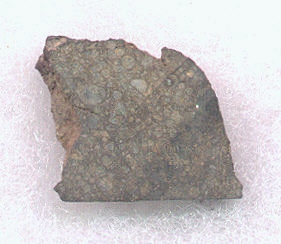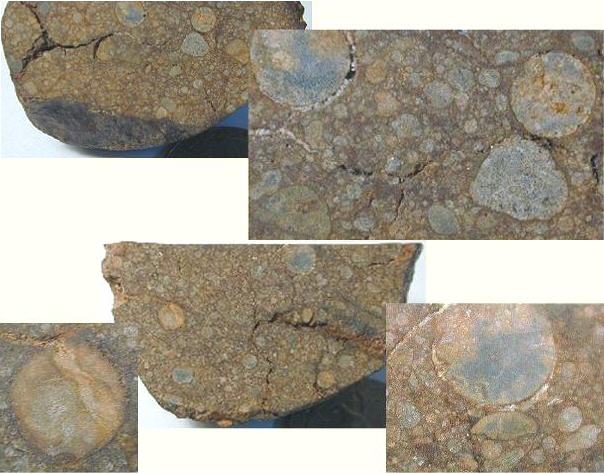E3
(probably EL3)

purchased December 2000
no coordinates recorded A 210 g meteorite was purchased by Canadian meteoriteWork in progress. A solid natural object reaching a planet’s surface from interplanetary space. Solid portion of a meteoroid that survives its fall to Earth, or some other body. Meteorites are classified as stony meteorites, iron meteorites, and stony-iron meteorites. These groups are further divided according to their mineralogy and Click on Term to Read More dealer D. Bessey in Erfoud, Morocco. Upon cutting, it was considered that it was a particularly nice LL3 and was used to make thin sections. Thereafter, a 34.7 g sample and a thin sectionThin slice or rock, usually 30 µm thick. Thin sections are used to study rocks with a petrographic microscope. were sent to the Russian Academy of Sciences in Moscow for analysis and classification. The preliminary analysis conducted by S. Afanasiev (Vernad) led to the determination that this was an E3 chondriteChondrites are the most common meteorites accounting for ~84% of falls. Chondrites are comprised mostly of Fe- and Mg-bearing silicate minerals (found in both chondrules and fine grained matrix), reduced Fe/Ni metal (found in various states like large blebs, small grains and/or even chondrule rims), and various refractory inclusions (such Click on Term to Read More (Fs1.11, An10.8) with a shock stageA petrographic assessment, using features observed in minerals grains, of the degree to which a meteorite has undergone shock metamorphism. The highest stage observed in 25% of the indicator grains is used to determine the stage. Also called "shock level". Click on Term to Read More of S2 and a weathering grade of W3.
From the preliminary data, including the fact that the
chondruleRoughly spherical aggregate of coarse crystals formed from the rapid cooling and solidification of a melt at ~1400 ° C. Large numbers of chondrules are found in all chondrites except for the CI group of carbonaceous chondrites. Chondrules are typically 0.5-2 mm in diameter and are usually composed of olivine Click on Term to Read More diameter is relatively large compared to EH
chondrulesRoughly spherical aggregate of coarse crystals formed from the rapid cooling and solidification of a melt at ~1400 ° C. Large numbers of chondrules are found in all chondrites except for the CI group of carbonaceous chondrites. Chondrules are typically 0.5-2 mm in diameter and are usually composed of olivine Click on Term to Read More, it might be inferred that NWA 305 belongs to the EL chondrite group. Only a few EL3
chondritesChondrites are the most common meteorites accounting for ~84% of falls. Chondrites are comprised mostly of Fe- and Mg-bearing silicate minerals (found in both chondrules and fine grained matrix), reduced Fe/Ni metal (found in various states like large blebs, small grains and/or even chondrule rims), and various refractory inclusions (such Click on Term to Read More are currently known, including several from the Antarctic (
e.g., ALH 85199, MAC 88180, and PCA 91020), one from Australia (Watson 007), EL3 xenoliths identified in the
carbonaceous chondriteCarbonaceous chondrites represent the most primitive rock samples of our solar system. This rare (less than 5% of all meteorite falls) class of meteorites are a time capsule from the earliest days in the formation of our solar system. They are divided into the following compositional groups that, other than Click on Term to Read More Kaidun (designated Kaidun IV) and in the ureilite Almahata Sitta (designated
MS-MU-002), and a few from Northwest Africa (
e.g., NWA 3132, NWA 6508, NWA 7406). Therefore, NWA 305 could eventually prove to be an important addition to this highly unequilibrated
enstatiteA mineral that is composed of Mg-rich pyroxene, MgSiO3. It is the magnesium endmember of the pyroxene silicate mineral series - enstatite (MgSiO3) to ferrosilite (FeSiO3). Click on Term to Read More meteorite suite. Further information on the classification determinants and the petrogenesis of the E chondrites can be found on the
Saint-Sauveur page.
The specimen of NWA 305 shown above is a 5.17 g partial end section. Shown below is a comparison between the E3 chondrite NWA 305 in the top composite photo, and two EL3 chondrites in the bottom composite photo, comprising NWA 6508 (bottom) and NWA 7406 (top). It is obvious that there is a very close similarity in the appearance of chondrules and
matrixFine grained primary and silicate-rich material in chondrites that surrounds chondrules, refractory inclusions (like CAIs), breccia clasts and other constituents. Click on Term to Read More among all of these meteorites, and it is probable that NWA 305 is an EL3 chondrite.

Photos courtesy of Dean Bessey

Photos courtesy of Jason Utas; see more here >>
fallsandfinds.com









